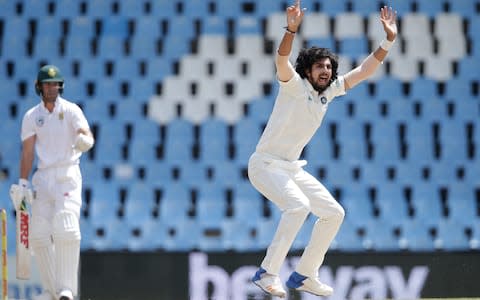Ishant Sharma: 'I can’t blame anyone why I didn’t become a spinner. It’s good for me to be a fast bowler - even in India'

Ishant Sharma knows that his career would have been easier if he was English. For in India, bowling fast can seem as futile as playing chess against Garry Kasparov. “You got the slow wickets – doesn’t bounce, spinners are into the game most of the time,” says Sharma, with a slightly long-suffering air. He has been trying to overcome these limitations for 11 years in Test cricket, one of the longest careers of any Indian fast bowler.
On India’s last Test tour of England in 2014, Sharma took seven for 74 to seal a famous Indian victory at Lord’s. He embraces bowling in England like a farmer greets rain after months of drought.
“The weather is so nice, you can bowl long spells, the conditions are helpful. The ball is nice, the wicket is favourable. There’s a lot of difference between bowling in England and India.” In England, where Sharma has been preparing with a stint at Sussex, the order he knows in India is reversed. “Spinners need to contain the runs, and fast bowlers are the ones who are going to take the wickets.”
And yet Sharma has built a career upon his durability in Indian conditions. For all his qualities – consistency, variety, bounce from his 6ft 4in frame – perhaps most important is the sheer bloody-mindedness that has sustained Sharma during 11 years in Test cricket. He is celebrating for bowling the “dirty overs”: those times when the ball has gone soft, the batsmen are set and the heat is unforgiving.
“I’m not really the kind of guy who likes to give up on things, so I’m really hard on myself,” he says. “I’m the kind of a person, when the things are really tough I really want to take it on.” Sometimes he has to “keep on going till the time I don’t get what I want”: a snapshot into the psyche of the Indian fast bowler.

In many ways the performance that encapsulates Sharma’s career contained just one of his 238 Test wickets. It was the second day of the second Test against Australia in Bangalore in 2017. Australia had thumped India in the first Test and bundled them out for 189 to begin the second; they were probably just one day away from retaining the Border-Gavaskar trophy. India, unusually, had only four specialist bowlers: two spinners and two seamers.
In fierce heat and with the series on the line, Sharma had to wring out every ounce of himself. He toiled through 27 overs – harrying Australia and so unerring in his accuracy that he even becalmed Steve Smith.
His spell on the first morning of the second day did not claim a wicket, yet it helped change the whole narrative of the Test and the series. At the start of the day, he told Umesh Yadav, India’s other quick: “Look, we already lost one Test match, so we just need to run in hard and do things for the team.” There is a famous photo of his spell, of Sharma’s eyes almost popping out during a tussle with Smith.
The sheer force of Sharma's will choked Australia, who added just 197 in a complete day’s play; when they were bowled out the next day, Sharma had final figures of one for 48 to show for 27 overs of drudgery and bad luck. When India sealed an epic victory in the fourth innings, Sharma snared an early wicket before stepping aside for the spinners to win the game – so often the Indian pace bowler’s fate.
“Whatever I choose is my choice, so I can’t really blame anyone why I didn’t become a spinner and why I’m a fast bowler,” Sharma jokes. “Fast bowling – obviously it’s a difficult thing to do, a lot of toll on your body. But it’s a really enjoyable thing as well. It tests your character, tests your strength. It’s really good for me to be a fast bowler. Even in India I’m still happy.”

When Sharma emerged, harassing Ricky Ponting in Australia in the winter of 2007-08, he was celebrated as one of India’s first 90mph fast bowlers. Now he is just one of three in India’s Test squad, along with Yadav and Mohammed Shami.
“Everybody used to say that India can’t produce a fast bowler, now we have probably eight to nine good fast bowlers anytime who can play Test cricket for India,” he said. This attack is why India scent history: they have never beaten England away over more than three Tests, and have never defeated Australia, who they visit over Christmas, away at all. “We have a pretty good chance to win a series in England and Australia, because of the kind of attack we have.”
Over his career, Sharma has seen the culture of Indian cricket transformed. The most significant shift is simply greater professionalism.
“We have become so much fitter because there’s so much knowledge, and there’s so much contribution from everyone. You know, talking about how important your fitness is if you want to play a good amount of cricket for the country. So you need to work hard for that. You can’t just bowl or just bat. You need to go into the gym. You need to go running, you need to look after your recovery system, you need to look after your diet and everything. Everybody has become a professional now instead of just thinking ‘you just need to bowl’.”

Before 2011, “I was not one who really believed in training,” Sharma reflects. “I didn’t have too much knowledge about training. So I wasn’t training that much. When I went home I was not doing anything, just relaxing. I think that’s the point I changed my life, and improved my cricket skill level.”
Since Virat Kohli was appointed captain in 2015, there has been another decisive change, with the team embracing sports science and the insights of the National Cricket Academy. “When you’re not playing then you have to go to the NCA and start training.” Under Kohli, there has been a “totally different training scenario – following different kinds of diet and everything. I think it’s totally changed now.”
Sharma has adapted to these shifts, not been submerged by them, becoming fitter, a better trainer and a better fielder. He has also become a clever, more reliable bowler. Sharma averaged 38.81 until 2014, but has since taken 89 wickets at 30.02 apiece, helped by more reliable Indian catching.
“Earlier I was really raw. I didn’t know much about bowling – I would just bowl fast. Now I know like, what the batsman is doing, how’s the weather, how the wicket is going to behave, then after how many overs what you need to do and everything. You need to adapt, and bowl according to the situation.”
That is Sharma’s way. And so, whether England’s Indian summer holds or gives way to more sepulchral skies, he will remain the same: versatile, wholehearted, uncomplaining and probably underappreciated, except by his team-mates.

 Yahoo Sport
Yahoo Sport 





































